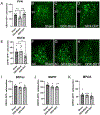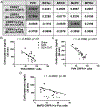Androgen Regulation of Corticotropin Releasing Factor Receptor 1 in the Mouse Brain
- PMID: 35398506
- PMCID: PMC9489527
- DOI: 10.1016/j.neuroscience.2022.04.005
Androgen Regulation of Corticotropin Releasing Factor Receptor 1 in the Mouse Brain
Abstract
Stress-related mood disorders like anxiety and depression are more prevalent in women than men and are often associated with hypothalamic-pituitary-adrenal (HPA) axis dysregulation. Androgen actions through androgen receptors (ARs) decrease HPA axis responses and stress-associated behaviors. Corticotropin releasing factor (CRF) and its binding to CRF receptor 1 (CRFR1) is also critical for regulation of the HPA axis, anxiety, and depression. We first determined CRFR1/AR co-localization patterns in male and female CRFR1-GFP mice. High co-localization was found within the paraventricular nucleus (PVN), dorsolateral and anteroventral subdivisions of the bed nucleus of the stria terminalis (BSTdl and BSTav), medial preoptic area (MPOA), and posterodorsal medial amygdala (MePD). We next determined whether the non-aromatizable androgen dihydrotestosterone (DHT) regulates CRFR1 expression and stress-induced activation of CRFR1-expressing cells. In the PVN, CRFR1-GFP cell number decreased following gonadectomy (GDX), but DHT treatment reversed this effect. GDX-DHT treated mice also had a decreased CRFR1-GFP cell number within the BSTdl compared to gonad intact and GDX-untreated groups. Following restraint stress GDX-blank mice showed fewer c-Fos/CRFR1 co-localized neurons in the MePD compared to gonad intact and GDX-DHT groups indicating decreased stress-induced activation of CRFR1 neurons following GDX. Higher plasma corticosterone (CORT) was found in GDX males compared to GDX-DHT and sham males following restraint stress, with a negative correlation between PVN CRFR1+ neurons and corticosterone levels 30- and 90-min following restraint. Together these findings show androgens can directly alter CRFR1 levels in the brain which may have implications for sex differences in regulation of the HPA axis and stress-related behaviors.
Keywords: Stress; androgen; androgen receptor; corticotropin releasing factor; hypothalamic–pituitary–adrenal axis; sex difference.
Copyright © 2022 IBRO. Published by Elsevier Ltd. All rights reserved.
Conflict of interest statement
Conflict of Interest
None declared.
Figures







References
-
- Bingham B, Myung C, Innala L, Gray M, Anonuevo A, Viau V. Androgen receptors in the posterior bed nucleus of the stria terminalis increase neuropeptide expression and the stress-induced activation of the paraventricular nucleus of the hypothalamus. Neuropsychopharmacology. 2011. Jun;36(7):1433–43. doi: 10.1038/npp.2011.27. Epub 2011 Mar 16. - DOI - PMC - PubMed
-
- Chen CV, Brummet JL, Jordan CL, Breedlove SM. Down, But Not Out: Partial Elimination of Androgen Receptors in the Male Mouse Brain Does Not Affect Androgenic Regulation of Anxiety or HPA Activity. Endocrinology. 2016. Feb;157(2):764–73. doi: 10.1210/en.2015-1417. Epub 2015 Nov 12. - DOI - PMC - PubMed
Publication types
MeSH terms
Substances
Grants and funding
LinkOut - more resources
Full Text Sources
Research Materials

